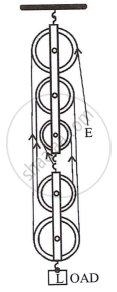Advertisements
Advertisements
Question
In following figure, draw a tackle to lift the load by applying the force in the downward direction.
- Mark in the diagram the direction of load L and effort E.
- If the load is raised by 1 m, through what distance will the effort move?
- State how many strands of tackle are supporting the load?
- What is the mechanical advantage of the system?

Solution
- The load and effort direction are shown in the figure.

-
If the weight travels a distance d in a block and tackle, the effort travels a distance nd.
Where n is the number of pulleys.
∵ Each string is shortened by a length d i.e. dL = d then dE = 1m
∴Effort will move through = 5 × 1 = 5m - Five strands are supporting the load.
- M.A. of system = `"Load"/"Efffort"`
= `(nT)/T`
= n = 5
APPEARS IN
RELATED QUESTIONS
A coolie uses a sloping wooden plank of length 2.0 m to push up a drum of mass 100 kg into the truck at a height 1.0 m.
(a) What is the mechanical advantage of the sloping plank?
(b) How much effort is needed to push the drum up into the truck?
What assumption have you made in arriving at the answer in part (b) above?
A Woman draws water from a well using a fixed pulley. The mass of bucket and water together is 6 kg. The force applied by the woman is 70 N. Calculate the mechanical advantage. (Take g = 10 m s-2)
A fixed pulley is driven by a 100 kg mass falling at a rate of 8.0 m in 4.0s. It lifts a load of 75.0 kgf. Calculate the power input to the pulley taking the force of gravity on 1 kg as 10 N.
A block and tackle system has 5 pulleys. If an effort 0f 1000 N is needed in the downward direction to raise a load of 4500 N, calculate:
- the mechanical advantage
- the velocity ratio, and
- the efficiency of the system.
In following figure, shows a system of four pulleys, The upper two pulleys are fixed and the lower two are movable.
- Draw a string around the pulleys. Also show the place and direction in which the effort if applied.
- What is the velocity ratio of the system?
- How are load and effort of the pulley system related?
- What assumption do you make in arriving at your answer in part (c)?

Class I lever can have M.A. = 1, M.A. < 1 and M.A. > 1. Explain each giving examples.
A fixed pulley is driven by a 100 kg mass falling at a rate of 8.0 m in 4.0 s. It lifts a load of 75.0 kgf. Calculate the efficiency of the pulley.
A single fixed pulley and a movable pulley both are separately used to lift a load of 50 kgf to the same height. Compare the efforts applied in an ideal situation.
A woman draws water from a well using a fixed pulley. The mass of the bucket and water together is 60 kg. The force applied by the woman is 70 N. Calculate the mechanical advantage. [Take g = 10 m/s2].
